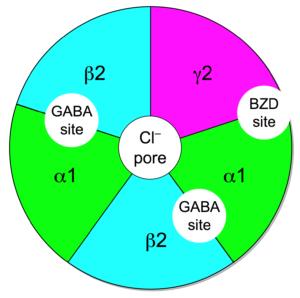Can the terpenes in cannabis really have relaxing or anti-anxiety effects? What happens when they are combined with THC?
Every cannabis site loves to talk about the “health benefits” of terpenes. Many cannabis terpenes are promoted as having calming, sleep-promoting, anti-stress, anti-anxiety effects. When I hear these descriptions, it sounds to me like they are sedatives.
Unfortunately there is often little detail on the science behind these claims. In fact, it was difficult to even find a proper review on sedative effects of terpenes in the scientific literature. So I made this guide on the sedative and anxiolytic (anti-anxiety) effects of terpenes to understand the science behind what they do and how they work.
Note that I am not including studies on the effects of terpenes tested as aromatherapy. There is some interesting research in this area, but I will cover this in a separate article. This article will focus on the effects of terpenes taken internally.
I will focus primarily on animal and mechanistic studies. The reason? There is actually very little research on isolated terpenes in humans. However, I will be covering what research is available in a future article.
What Are The Properties of Sedatives?
We need to be a little more specific when we say that a terpene has sedative or calming effects. Not every sedative is exactly the same, but many share some basic properties that I will describe below.
- Reduced physical activity: This is the most classic sedative effect, akin to the “couch-lock” described for some cannabis strains.
- Hypnotic: This is the ability to induce sleep. Sedatives may both reduce the time to fall asleep as well as induce a longer period of sleep.
- Anxiolytic: Many sedatives will reduce anxiety.
- Anticonvulsant: Due to inhibiting neuronal activity, sedatives can reduce the frequency or intensity of seizures.
- Motor coordination: Sedatives typically impair coordination. Hence you will see this warning on pharmaceutical sedatives: “Do not drive or operate heavy machinery”.
Which Cannabis Terpenes Are Reported To Have Sedative Effects?
The terpenes in cannabis are found in the essential oils of many other plants. Many of these plants have had traditional medicinal uses for hundreds of years. Some of these traditional medicinal uses include calming or sleep-inducing effects (basically the things that a sedative would be used for). Here is a list of terpenes that traditional use or modern research indicates have sedative or anxiolytic effects:
- β-Caryophyllene
- Limonene
- Linalool
- Myrcene
- α-Pinene
- Phytol
- α-Terpineol
- Terpinolene
Note: This list is not exhaustive, but I believe it contains the most important ones. I will explore in the sections below whether there is any evidence to support the claims that these terpenes have sedative properties.

Myrcene, α-Pinene, Phytol, Terpinolene, and α-Terpineol
I am lumping 5 of the terpenes together, because they seem to act in the same way. All have similar activities in rodents and all have a similar mechanism of action by working through the GABA system.
Sedative Activity of GABAergic Terpenes in Animals
Myrcene had a variety of sedative effects in rodents (100-200 mg/kg i.p.). It suppressed locomotor activity, induced sleep, and reduced motor coordination in the rotarod test, although it did not show anxiolytic effects. Another study showed that myrcene (200 mg/kg i.p.) reduces seizure activity.
α-Pinene similarly suppresses locomotor activity (0.2-0.4 mg/kg i.p.). Another study showed an increase in sleep time(100 mg/kg oral). α-pinene did not impair motor coordination, although only doses up to 0.17 mg/kg were tested. Inhalation of α-pinene (which produced measurable concentrations in the brain) produced an anxiolytic effect, although higher brain concentrations were associated with an excitatory effect. I did not find any studies that looked directly at the anticonvulsant activity of α-pinene, but several essential oils that have α-pinene as a component reduced seizures.
Phytol has shown numerous sedative activities in rodents. It showed sedative effects in the open field test (25-75 mg/kg i.p.), increased sleep time (25-75 mg/kg i.p.), had anxiolytic effects (75 mg/kg i.p.), and impaired motor coordination (75 mg/kg i.p). Another study showed that phytol has anticonvulsant activity (25-75 mg/kg i.p.)
Terpinolene (0.01-0.1 mg/kg i.p.) significantly reduced locomotor activity. Other sedative activities of terpinolene have not been tested.
Mechanism of GABAergic Terpenes Sedative Activity
GABA is the main inhibitory neurotransmitter in the brain and it exerts its effects through reducing neuronal excitability. There are two receptors for GABA – the GABAA receptor (an ion channel) and the GABAB receptor (a G protein-coupled receptor).
A class of sedatives called benzodiazepines work through the GABAA receptors. They can bind to a distinct receptor site and act as positive allosteric modulators of GABA. In other words, they can increase activation of the receptor by GABA.


The GABA-A receptor with binding sites [Wikipedia]
There is a variety of evidence that the terpenes described above exert their effect through the same benzodiazepine binding site of GABAA receptors . For one, the pharmacologic profile of these terpenes is similar to that of benzodiazepines. Flumazenil, which is an antagonist of the benzodiazepine binding site, blocks the effects of these terpenes in vitro and in vivo.
Myrcene and α-pinene increased GABAA receptor activity in cell experiments. The effect of α-pinene in neurons was fully blocked by flumazenil. In rodents, flumazenil blocked the sedative effects of lemongrass oil (which has high myrcene content), α-pinene, and phytol.
α-terpineol can also increase GABAA activity in cells. Even though its pharmacology in rodents has not been characterized, we can assume that it will be similar to the other GABAergic terpenes.
Phytol may have an additional GABA-related mechanism through inhibiting SSADH, which is is the enzyme that breaks down GABA. Thus, it may be able to raise GABA levels in the brain in addition to increasing activation of the GABAA receptor.
Possible Synergy of GABAergic Terpenes with Cannabinoids
GABAA stimulating drugs (like the benzodiazepine flurazepam) synergistically increased the cataleptic effects of THC in mice. Catalepsy is the decreased ability to initiate movement. This enhancement of THC’s cataleptic effects occurred at a dose of flurazepam so low that it did nothing by itself. Although THC’s cataleptic effects are distinct from sedative effects (and are also much more subtle in humans than rodents), this may contribute to the couch-lock effect.
Another study indicated that chronic (but not acute) cannabis treatment in mice actually increased affinity of benzodiazepines for their binding site. Since the GABAergic terpenes bind to this same site as benzodiazepines, it is possible that the anxiolytic effects of low doses of terpenes may be greater in chronic cannabis users.
Adding diazepam to a dose of THC in regular cannabis users did not significantly impact subject’s self-rated high. They did feel more sedated after the THC/diazepam combination, but this effect was more additive than synergistic at the diazepam doses tested. This does not negate the possibility that there is synergistic activity with lower doses of terpenes.


Limonene
Sedative Activity of Limonene in Animals
Limonene has shown most of the classic sedative effects in animal studies. A study in rodents found that limonene reduced locomotor activity (100-200 mg/kg i.p.), induced sleep (200 mg/kg i.p.), and impaired motor coordination (50 mg/kg i.p.). However, it did not show anxiolytic effects in the elevated plus maze test. Limonene was also an anticonvulsant (200 mg/kg i.p.).
The anti-stress effects of limonene have also been tested. Limonene (0.84 mg/kg i.p.) significantly reduced serum corticosterone levels (a stress hormone) elevated by physical or social stress. It also reversed many of the changes in in brain monoamine neurotransmitters induced by these stressors, including dopamine, norepinephrine, and serotonin.
Another study looked at chronic dosing with d-limonene (one of the two limonene enantiomers). After 1 week of limonene dosing, brain glutamate levels were decreased and brain GABA levels were increased (both at 25-50 mg/kg i.p.). There were minimal changes in brain monoamine neurotransmitters and serum corticosterone in the absence of any stressor. However, limonene did partially block stress-induced increases in serum corticosterone.
Mechanism of Limonene Sedative Activity
The sedative mechanism of limonene may be multifaceted. On one hand, the decrease in brain glutamate and increase in brain GABA may be responsible for part of the sedative effect, although it is not clear whether this happens after single doses or only with chronic dosing.
Although limonene had no direct effect on the GABAA receptor in cells, the GABAA receptor benzodiazepine binding site has a role in vivo. Some (but not all) of the changes in brain monoamine neurotransmitters from limonene were reversed by flumazenil. In a study of monoamine neurotransmitter release from rat brain slices, the limonene metabolites perillic acid and perillyl alcohol acted more strongly than limonene itself. These metabolites may have a benzodiazepine-like activity at the GABAA receptor which limonene itself lacks.
Finally, a 2011 study and 2015 study showed that limonene could directly bind to and activate the adenosine A2Areceptor. Caffeine, a known stimulant, is an antagonist of this receptor along with the other adenosine receptor subtypes. The adenosine A2A receptor can regulate glutamate, GABA, and dopamine release, so this may be another mechanism through which limonene regulates neurotransmitter release.
Possible Synergy of Limonene with Cannabinoids
Since limonene (or rather its metabolites) increased GABAA activation, the same situation described above for the GABAergic terpenes may also apply to limonene.
In some cases, A2A activation can increase the effects of cannabinoids and in some cases decrease the effects. Interestingly, the A2A receptor can form a receptor heterodimer with the cannabinoid CB1 receptor. Complicating the matter further, CB1 activation results in indirect A2A activation. Also, THC and CBD are both inhibitors of the adenosine reuptake transporter, ENT1.
Basically, interactions between the cannabinoid and adenosine systems are complex, making it difficult to speculate on synergy between THC and limonene.


Linalool
Sedative Activity of Linalool in Animals
A 2008 study in rodents showed that linalool decreased locomotor activity (175 mg/kg i.p.), but was not anxiolytic at 125 mg/kg i.p. A 2012 study showed that linalool reduced locomotor activity (100-173 mg/kg i.p.), without a loss of motor coordination at 100 mg/kg. Linalool also increased sleep and had anticonvulsant properties (350 mg/kg i.p. and 2200-2500 mg/kg oral).
Two weeks of dosing with the two linalool enantiomers (500 mg/kg oral) revealed that both produced anxiolytic activity without locomotor effects.
Mechanism of Linalool Sedative Activity
Linalool does not bind to the GABA site or to the benzodiazepine site of the GABAA receptor. Nonetheless, a 2014 study showed it could significantly augment GABAA activity in cells.
There is another mechanism of linalool that differentiates it from other terpenes. It can modulate the effects of glutamate, which is the main excitatory neurotransmitters in the brain. Glutamate can act through four different receptors. A 2017 study (and other earlier studies) showed that linalool is an antagonist of the NMDA receptor,which is one of these glutamate receptors. Other NMDA receptors antagonists include dissociative anaesthetics such as ketamine, which have strong sedative activity.
Possible Synergy of Linalool with Cannabinoids
The hypothermic and reduced locomotor activity of THC itself are (at least partially) mediated through cortical glutamatergic neurons. There was a distinct synergistic effect on hypothermia when a CB1 agonist was combined with an NMDA receptor antagonist (at a dose so low, it had no effect by itself). This highlights the possibility that there is also a synergistic sedative effect of low doses of linalool when combined with THC.
β-Caryophyllene
Sedative Activity of β-caryophyllene in Animals
The sedative properties of β-caryophyllene were characterized in a 2012 study, 2014 study, and 2016 study and were shown to be distinct from the GABAergic terpenes. In rodents, β-caryophyllene did not affect locomotor activity or motor coordination (doses up to 100 mg/kg i.p. and 200 mg/kg oral). However, it did mildly promote sleep (200-400 mg/kg oral), have anxiolytic activity (50 mg/kg i.p and 100-200 mg/kg oral), and have antiseizure activity (100 mg/kg i.p.).
Mechanism of β-caryophyllene Activity
β-caryophyllene is a cannabinoid CB2 receptor agonist, and has therefore been called a “dietary cannabinoid”. The anti-anxiety effects from one study were completely blocked by a CB2 receptor antagonist, indicating that this is the sole mechanism of its anxiolytic effect. This was supported by another study, where anti-anxiety effects were not mediated through either the GABAA benzodiazepine site or through the 5-HT1A receptor. The lack of effect on locomotor activity and coordination further confirm that β-caryophyllene does not work through the GABA system. Therefore, at the right dose, it can be considered a non-sedating anxiolytic.
Possible Synergy of β-caryophyllene with Cannabinoids
Since THC is already a partial agonist of the CB2 receptor, I would expect little synergy between the two molecules. It is possible that there is a synergistic anti-anxiety effect between β-caryophyllene and CBD, since both exert their effects through different mechanisms. However, CBD is also a weak antagonist of the CB2 receptor and so high CBD doses may actually block the anxiolytic effects of β-caryophyllene.


Do Cannabis Terpenes Have Sedative or Anxiolytic Effects in Humans?
This is the million dollar question. Unfortunately I have run out of time and will have to address this in detail in a future article. In general, the evidence supporting these effects in humans is weak (but remember that absence of evidence is not evidence of absence).
Why did I bother to list all of the doses used in the animal studies above? The terpene doses required to see sedative effects in animals were generally very high…it would be near impossible to achieve equivalent doses through consumption of cannabis. While it is possible that a lower terpene dose is sufficient due to synergistic interactions with THC, this remains unproven in humans.
Another possibility is that terpenes exert some effects directly through their smell and not actual ingestion (i.e. aromatherapy). The jury is still out on this as well, but there have indeed been some studies that support it.
Original Article : http://profofpot.com/sedative-anxiolytic-effects-cannabis-terpenes/








